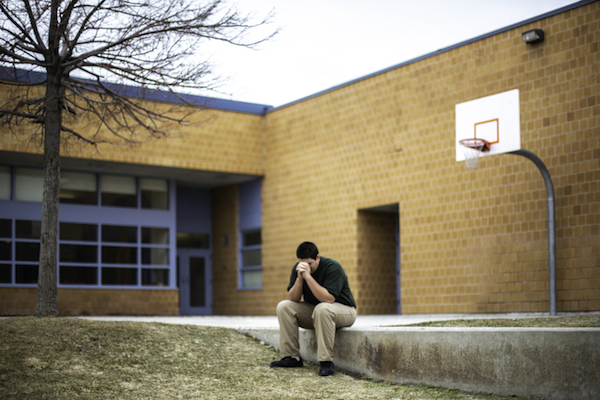Every time a reformer proposes a new idea in education, critics and skeptics demand evidence. Our state and federal laws prefer evidence-based practices and reward the adoption of practices backed by valid and reliable research. But when defending the status quo, no one ever seems interested in the evidence.
Last week’s Chicago Tribune piece on the disturbing use of “quiet rooms” as a behavior management strategy indicated that these euphemistically named rooms are in use across the state of Illinois. Children are routinely placed into isolation when they misbehave, under the pretense of behavior management or time to reflect. These rooms are isolation masquerading as quasi-in-school suspension, and there is, of course, no evidence to support them. In fact, the evidence runs in the opposite direction: “time-outs” actively harm children. That doesn’t seem to stop schools from using them.

A student in Utah sits alone outside his classroom. From Bellwether’s Rigged series.
Beyond the extreme example of Illinois’ “quiet rooms,” isolation and other exclusionary discipline practices are pervasive and, for many, noncontroversial. This includes suspensions and expulsions, which enjoy mainstream support from teachers and policymakers. Stories of suspension and expulsion don’t carry the same visceral horror as these examples from Illinois, but they’re all based on the same fundamentally flawed premise: that you can compel any individual to behave well by demanding obedience through force and deprivation.
The problem with our easy comfort with exclusionary discipline is that it doesn’t work. It doesn’t work in schools — and it doesn’t work in any other context either.
Suspensions and expulsions are not evidence-based practices: there is no research that validly and reliably supports the claim that either is effective at changing individual student behavior, improving school culture, or raising academic outcomes. In fact, all of the research about other forms of exclusionary discipline, like the research about isolation, points very clearly the other way. Suspensions and expulsions are bad for kids and bad for schools. Excluding students from school escalates their behavior, increasing the chances of a future exclusion (even when controlling for the initial behavior), degrades school culture, and contributes to low academic outcomes. It is also disproportionately meted out to students of color, students with disabilities, and students who are, or perceived to be, LGBTQ.
Of course there are anecdotes of things going wrong when implementing new approaches to behavior management. Sometimes they have gone horribly, tragically wrong. But I would posit that if you stack those failures up and weigh them against the millions of students who have been brutally failed by the status quo, the difference would be staggering. What we do right now in schools is not just not evidence-based, but it’s proven to do exactly the opposite of what it’s supposed to: exclusionary discipline harms far more students than it protects.
Research on alternatives to traditional school discipline is still emergent, but if we care about evidence-based practices in education, then we have to acknowledge that the status quo is indefensible.